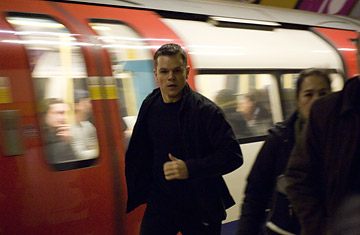
Matt Damon as Jason Bourne tries to evade capture in a scene from the film The Bourne Ultimatum.
2007; Director: Paul Greengrass; Writers: Tony Gilroy, Scott Z. Burns, George Nolfi
With Matt Damon, Julia Stiles, David Strathairn, Joan Allen, Albert Finney, Joey Ansah
Universal Studios
Available Dec. 11, List Price $29.99
Fight, run, drive, hit, jump, fight, kill. Critics praised this third and possibly final film in the saga of Robert Ludlum's amnesiac CIA hero as the thinking man's action movie. Well, the plotting and emotional subtext aren't That Smart, but this one is certainly the all-action action movie. A pounding of the eyes and ears (John Powell's score is all urgent percussion), the movie is one continuous, exhausting, exhilarating chase. "All movies are ultimately chase movies," Greengrass says on the very thoughtful commentary track. "And I wanted this film to be all about Bourne getting answers...the chase reaching its furious crescendo. And so, from the first frame, I wanted the tempo to be high." Half-the-film later, he returns to his theme: "The tempo is high, but the ride is sustained. And it's filled with this kind of texture and detail."
Greengrass walks, runs, us through the big action scene at London's Victoria Station, where Bourne evades most of his pursuers, fights off another half-dozen in a stairwell and saves the life of a source. "It's a funny thing when you see these sequences months after you've completed them," the director observes, "because you think, 'Well, it could only be like this. Every shot has to be in that order.' But of course, when you're actually wrestling with a monstrous great action sequence like this, you watch them literally hundreds upon hundreds of times in different ways, different orders, different pacing."
Studying your favorite fight scene — between Bourne and the CIA killer Desh (Ansah) in a Tangier apartment — you may be surprised to learn that the whole battle takes less than two mins., from Bourne's crashing through the window to Desh's demise. It seems longer, fuller, because it's been preceded by Bourne's tense navigation of the city's rooftops and his leap from a roof through a closed window one floor below in the next building. In a terrific action moment, we follow the Bourne stunt man on his trajectory; a second stunt man held a camera to record the jump. (One of the extras details how second unit director Dan Bradley designed the jump and got it done.)
Those who keep replaying this scene — and we mean all of you — will ask why Bourne would crash through the window head first. And why, when Bourne is trying to kill Dash, he picks up a hardback book and punches the book cover (ow!) instead of his adversary's pulpy face. The answer to both, I think, is that in the choice between ultimate-fighting plausibility and an audience-grabbing shot, filmmakers go for grab — though Greengrass says he insists on authenticity. "I'm not a great fan of designer violence myself," he says. "I think violence is desperate and brutal, ugly. And it's essential that Bourne discovers that in each film."
Uh-huh. That's why The Bourne Ultimatum is the top-selling new movie on Amazon.com: because fans want to see how desperate, brutal and ugly violence is — over and over and over again.